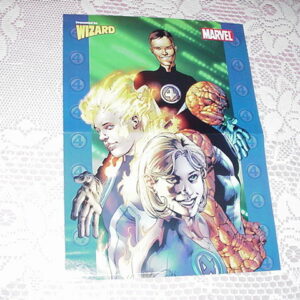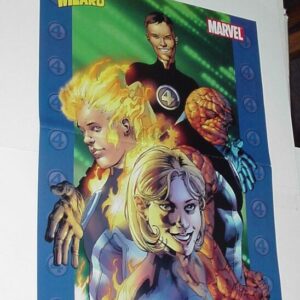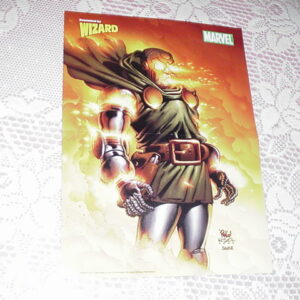Fantastic Four Poster #66 Doctor Doom (Victor von Doom) by Creator, Jack Kirby
$34.99
Description
Doctor Doom (Victor von Doom) is a supervillain that appears in publications by Marvel Comics. The son of gypsy witch Cynthia Von Doom, Doctor Doom is a recurring supervillain, archenemy of the Fantastic Four, and leader of the fictional nation of Latveria. He is both a genius inventor and a sorcerer. While his chief opponents have been the Fantastic Four, he has also come into conflict with Spider-Man and other superheroes in the Marvel Universe.
Created by writer-editor Stan Lee and artist/co-plotter Jack Kirby, the character first appeared in The Fantastic Four #5 (July 1962) wearing his trademark metal mask and green cloak.
With the Fantastic Four title performing well, Lee and Kirby were trying to dream up a “soul-stirring…super sensational new villain.” Looking for a name, Lee latched onto “Doctor Doom” as “eloquent in its simplicity — magnificent in its implied menace.”
Jack Kirby modeled Doctor Doom after Death, with the armor standing in for that character’s skeleton; “It was the reason for the armor and the hood. Death is connected with armor and the inhuman-like steel. Death is something without mercy, and human flesh contains that mercy.” Kirby further described Doctor Doom as being “paranoid”, wrecked by his twisted face and wanting the whole world to be like him. Kirby went on to say that “Doctor Doom is an evil person, but he’s not always been evil. He was respected…but through a flaw in his own character, he was a perfectionist.” At one point in the 1970s, Kirby drew his interpretation of what Doctor Doom would look like under the mask, giving Doctor Doom only “a tiny scar on his cheek.” Due to this slight imperfection, Doctor Doom hides his face not from the world, but from himself. To Kirby, this is the motivation for Doctor Doom ‘s vengeance against the world; because others are superior due to this slight scar, Doom wants to elevate himself above them. Typical of Lee’s writing characterization of Doctor Doom is his arrogance; his pride leads to Doctor Doom’s disfigurement at the hands of his own machine, and to the failures of many of his schemes. There is also an idea that Doctor Doom placed his mask on his face before it was fully cool, burning his face. In some early stories glimpses of his face are shown, in which he appears to be bald.
While the Fantastic Four had fought various villains such as the Mole Man, Skrulls, the Miracle Man, and Namor the Sub-Mariner, Doctor Doom managed to overshadow them all and became the Fantastic Four’s archnemesis.
Doctor Doom is a polymath and scientific genius. Throughout most of his publication history, he has been depicted as one of the most intelligent humans in the Marvel Universe. This is shown on many occasions, most famously by actually curing Ben Grimm of his Thing form, which Reed Richards has never repeated. On the other hand, Reed Richards managed to process all the computer calculations necessary to save the life of a disintegrating Kitty Pryde by himself, which is a feat that Doctor Doom at the time professed to be unable to do.
Doctor Doom also possesses originally minor mystical capabilities due to teachings from Tibetan monks, but later increased them to a considerable extent due to tutoring from his lover Morgan Le Fay. He is capable of energy projection, creating protective shields, and summoning hordes of demonic creatures. Even at a time his abilities were consistently referred to as minor, with assistance from his technology and by tag-teaming with Doctor Strange, Doctor Doom managed to come second in a magic tournament held by the ancient sorcerer the Aged Genghis.
Doctor Doom has also used his scientific talents to steal or replicate the power of other beings such as the Silver Surfer, or in one case the entity Galactus’ world-ship.
The alien Ovoids taught Doctor Doom the process of psionically transferring his consciousness into another nearby being through a simple eye contact, as well as showing him other forms of technology which Doctor Doom uses to escape from incarcerations and to avoid getting killed; however, if his concentration is broken, it can transfer his mind back, and he rarely uses this power unless absolutely necessary due to his own ego about his appearance.
Doctor Doom can exert technopathic control over certain machines, most notably,the Doom bots. In addition, Doctor Doom has a remarkably strong will, as demonstrated in the graphic novel, Emperor Doom when he dared his prisoner, the mind controlling Purple Man, to attempt to control him and he successfully resists.
Without his armor he proved himself to be a skilled bare-handed fighter, even capable of killing a lion.
Doctor Doom ‘s armor augments his natural physical strength to superhuman levels, to the point where he is able to hold his own against Spider-Man in hand-to-hand combat, although he tends to rely on long-range tactics when engaging physically stronger foes. It is also highly resistant to harm, sufficient to withstand blows from Iron Man’s armor. The armor can generate a defensive force field and a lethal electric shock killing anyone who might come in contact with Doctor Doom. The armor is self-supporting, equipped with internal stores and recycling systems for air, food, water, and energy, allowing the wearer to survive lengthy periods of exposure underwater or in outer space.
As the absolute monarch of Latveria, Dr. Doom has diplomatic immunity- allowing him to escape prosecution for most of his crimes- and total control of the nation’s natural and technological resources, along with its manpower, economy, and military.
One of Doctor Doom’s most ingenious creation is this functioning time machine. It consists of a platform 10 feet (3.0 m) by 10 feet (3.0 m) by 6 inches (150 mm) and a separate control console. Subjects stand upon the platform, while an operator works the controls. The device can transport characters to virtually any time and place in Earth’s timestream, and the operator can instantly return the travelers by manipulating the control console. Doctor Doom does not require the console to return to his own time—he can use the time-circuitry built into his own armor, allowing him to venture into time and return on his own without relying on someone to bring him back.
One of Doctor Doom’s greatest victories came during the Secret Wars mini-series. Galactus, sensing that the Beyonder could alleviate his perpetual hunger, immediately and aggressively charges into the Beyond-Realm through a dimensional rift, followed by Doctor Doom, who seeks power for his own purposes. Both are repelled, but the information gathered by Doom later enables him to use the body of the sound-based villain Klaw as a medium to steal the energies of Galactus’ Worldship and then the power of the Beyonder itself. With the Beyonder’s power, Doom constructs a 200-mile (320 km) high tower of golden stone as temporary quarters, and then states that he has given up his ambitions for conquest, instead simply being content with freeing his mother’s soul from Mephisto. The Beyonder’s consciousness then possesses Klaw’s damaged mind and manipulates Doom into unconsciously squandering his power against the superheroes, distracting him enough for the Beyonder to steal his power back.
Jack Kirby (August 28, 1917 – February 6, 1994), born Jacob Kurtzberg, was an American comic book artist, writer and editor regarded by historians and fans as one of the major innovators and most influential creators in the comic book medium. He and writer-editor Stan Lee co-created many of Marvel’s major characters, including the Fantastic Four, the X-Men, and the Hulk. Despite the high sales and critical acclaim of the Lee-Kirby titles, Kirby felt treated unfairly, and left the company in 1970 for rival DC. In 1987 he was one of the three inaugural inductees of the Will Eisner Comic Book Hall of Fame.
For almost a decade, Kirby provided Marvel’s house style, co-creating with Stan Lee many of the Marvel characters and designing their visual motifs. At Lee’s request, he often provided new-to-Marvel artists “breakdown” layouts, over which they would pencil in order to become acquainted with the Marvel look. As artist Gil Kane described: “Jack was the single most influential figure in the turnaround in Marvel’s fortunes from the time he rejoined the company … It wasn’t merely that Jack conceived most of the characters that are being done, but … Jack’s point of view and philosophy of drawing became the governing philosophy of the entire publishing company and, beyond the publishing company, of the entire field … Marvel took Jack and used him as a primer. They would get artists … and they taught them the ABCs, which amounted to learning Jack Kirby. … Jack was like the Holy Scripture and they simply had to follow him without deviation. That’s what was told to me … It was how they taught everyone to reconcile all those opposing attitudes to one single master point of view.”
Highlights other than the Fantastic Four include: the Hulk, Thor, Iron Man, the original X-Men, Doctor Doom, Uatu the Watcher, Magneto, Ego the Living Planet, the Inhumans and their hidden city of Attilan, and the Black Panther, comics’ first known black superhero—and his African nation of Wakanda. Kirby drew the first Spider-Man story intended for publication in Amazing Fantasy #15 but Stan Lee chose to have Steve Ditko redraw the story. Lee and Kirby gathered several of their newly created characters together into the team title The Avengers and would revive characters from the 1940s such as the Sub-Mariner, Captain America, and Ka-Zar. The story frequently cited as Lee and Kirby’s finest achievement is the three-part “The Galactus Trilogy” that began in Fantastic Four #48 (March 1966), chronicling the arrival of Galactus, a cosmic giant who wanted to devour the planet, and his herald, the Silver Surfer.
Near mint condition.
Related products
-


Iron Man Poster # 5 by Kev Walker Iron Doom Exiles 23 Cover
$29.99 Add to cart -


Ultimate Fantastic Four Poster # 1 Bryan Hitch Reed Johnny Sue Ben
$39.99 Add to cart -


Doctor Doom Poster # 3 Triumphant by Mike Wieringo Fantastic Four 67
$34.99 Add to cart -


Soulfire Poster # 1 Grace by Michael Turner Fathom
$39.99 Add to cart


